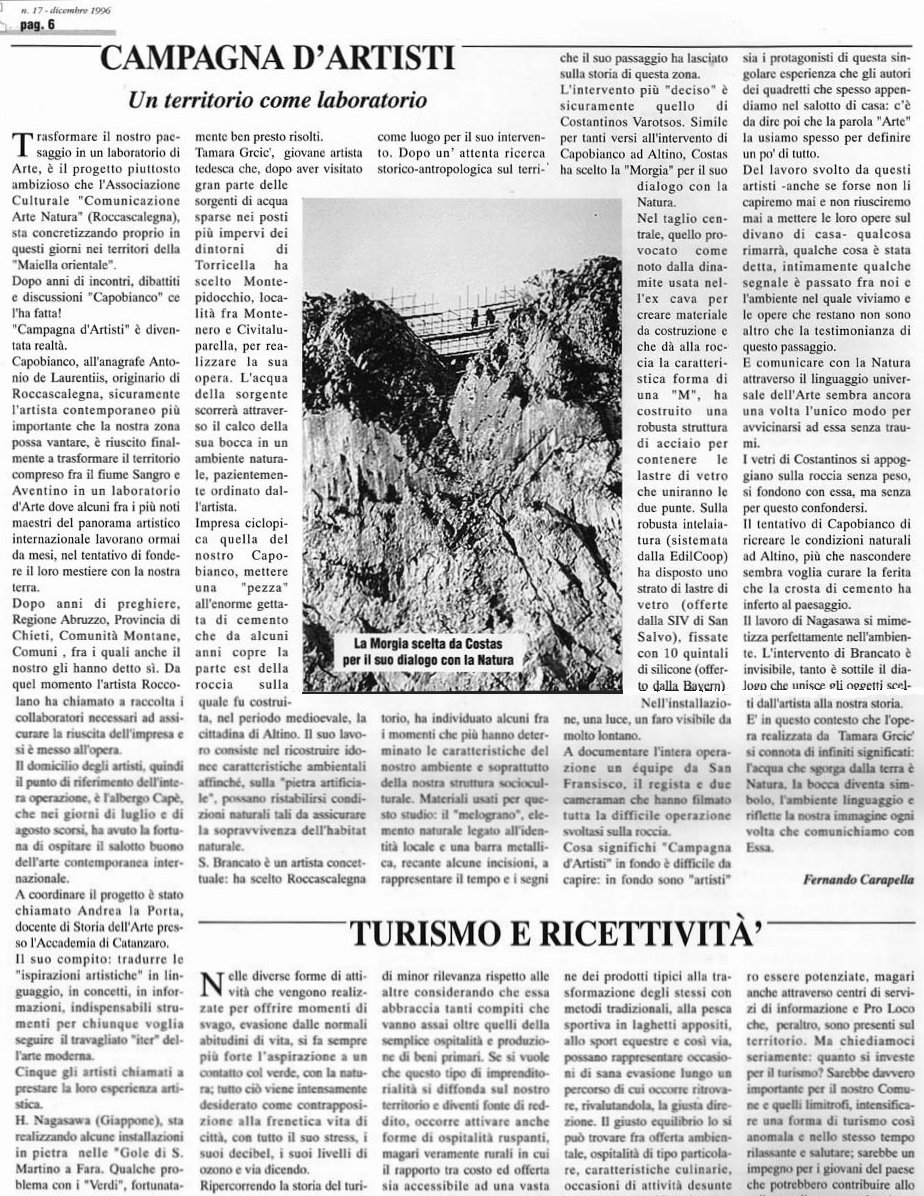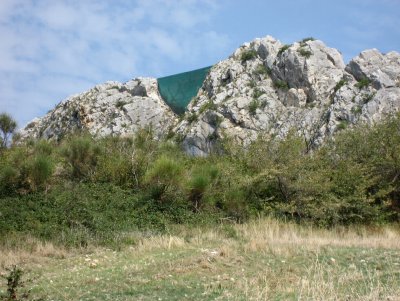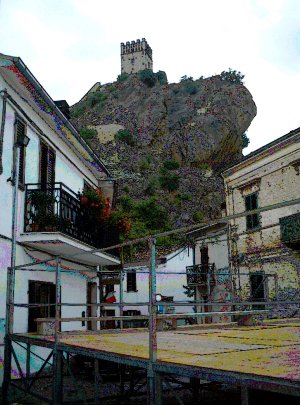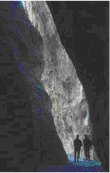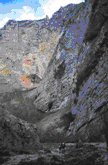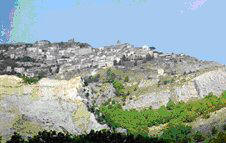|
© Amici di Torricella No. 17, dicembre/December 1996, p. 6 |
ARTISTS CAMPAIGN
A Territory as a Studio
By Fernando Carapella
To transform our landscape into an Artists’ Studio is a most ambitious project that the Cultural Association Art-Nature Communications” (of Roccascalegna[3]) is putting into concrete form at the moment (1996) in the territory of the eastern Majella.
After years of meetings, debates and discussion, “Capobianco” (White-head) has done it!The “Artists’ Campaign” has become a reality.
“White-head”, named at the registry office as Antonio de Laurentiis, from Roccascalegna, is certainly the most important contemporary artist of our region. He has finally succeeded in transforming the territory that lies between the Sangro and the Aventine Rivers into an Artists’ Studio (or workshop), where several of the most noted international masters of artistic landscapes have been working already for several months, in an attempt to merge their work with our land. After years of prayers, the Abruzzo Region, the Province of Chieti, the Mountain Community and the Town Halls, amongst which was also our own one, have said “Yes” to him. From that moment the Roccolano[4] artist has gathered together all the collaborators necessary for the success of this venture and he set to work. The “home” of these artists and thus their point of reference for the entire operation, is the Hotel Capè, which hosted the International Contemporary Art Exhibition last July-August (1996).
Andrea la Porta, lecturer in History of Art at the Accademia (Academy) of Catanzaro[5], was called upon to co-ordinate the project. His task was to translate “artistic inspiration” into language, concepts and formations which would indispensably be instrumental, for anyone who wants to, to follow the anguished “iter[6]” (journey) of modern art. Five artists were sent for to give of their artistic experience.
H. Nagasawa (from Japan) is creating some stone installations on the “Gole” di S. Martino (Gorges of S. Martino) at Fara[7]. There were some problems with the “Greens[8]” initially but these were soon solved.
Tamara Grcic', a young German artist, who, after having visited most of the springs scattered around Torricella, has selected Montepidocchio[9], a place situated between Montenero[10] and Civitaluparella[11] for carrying out her work. The spring water will run through a cast of her mouth into a natural environment, patiently and carefully tidied up by the artist.
A cyclopean[12] undertaking is that of our “White-head”, to put a “piece” on the enormous concrete casting that for several years has covered the eastern part of the rock on which the village of Altino[13] was built in medieval times. His work consists of reconstructing suitable environmental characteristics, so that, on this artificial “rock”, natural conditions can be re-established, that will ensure survival of the natural habitat.
S. Brancato is a conceptual artist; he chose Roccascalegna as the site for his work. After careful historical-anthropological research of the area, he has identified some of the many decisive moments delineating the character of our environment and of our social and cultural structure. The materials used for this study include the pomegranate, a natural element linked to local identity and an incised metal bar, representing time and the signs that the passage of time has left on the history of this zone.
The most “resolute” work is certainly that of Costantinos Varostos. Similar in many respects to “White-head’s” work at Altino, Costas chose the “Morgia[see 1]” for his dialogue with Nature.
This rock has a characteristic “M” shape at its centre, which is known to have been caused by dynamite, used when the site was part of a local quarry and was used to create building materials. At the central cut of the “M” he has built a sturdy steel structure that acts as a frame for the glass strips which unite the two points (of the “M”). Upon this strong framework (made by Edil Co-op) he has placed a layer of glass strips (given by SIV of Salvo), fixed with 10 quintals[14] of silicone (given by Bayern, Bavaria). There is a light within this work that, like a lighthouse, is visible from very far away.
An entire team from San Francisco was present to record the whole operation; the director and two cameramen filmed all the difficult work that was carried out on the rock.
What does “Artists’ Campaign” mean? It is quite difficult to understand. Basically “artists” are both the protagonists of this unique experience and also the authors of the pictures which we often hang in our living rooms at home. Then too we often use the word “Art” to define many diverse things.
From the works carried out by these five artists – even if maybe we never succeed in understanding them and will never be able to put their works above the sofa at home – something will remain, something has been “said”, some intimate signal has “passed” between us and the environment in which we live; and the works that remain are nothing more than a witness to this “passage”.
To communicate with Nature by means of the universal language of Art seems once again to be the only way of drawing closer to Nature without any trauma.
The glass strips of Costantinos rest on the rock weightlessly, they blend with it, yet they have not become mixed up with it.
“White-head’s” attempt to recreate natural conditions at Altino, rather than hiding the wound inflicted on the landscape by the cement crust, seem to want to heal it.
The work of Nagasawa camouflages itself perfectly within the environment. Brancato’s work is invisible, because of the extremely subtle nature of the dialogue linking the artist’s chosen objects to our history.
And in this sense the work carried out by Tamara Grcic' is distinguished by infinite meanings: the water that gushes out from the earth is Nature, the mouth becomes a symbol, the environment becomes a language and every time that we communicate with it (Nature), it reflects our image.
[1] The Morgia – is the name of a hard, rough outcrop of rock 130 metres high, that rises alone above a flat zone. The Morgia is a majestic limestone mass of natural panoramic beauty, which rises between Gessopalena and Torricella Peligna. It looks like the point of a prehistoric spear that is sticking out of the ground and it is visible from far away in the territory of Chieti.
There used to be a village near to the Morgia called Peschio Rotico. This village was wiped out in the plague at the end of the fourteenth century (the one mentioned by Boccaccio in The Decameron).
The Morgia was disfigured after the last war due to extraction work at an old quarry; in the late ‘80’s - early 90’s La Morgia” was again being destroyed by the advances of a stone quarry that threatened even more severe damage, but this was halted, thanks chiefly to the active campaigning of the late Lelio Porreca from Torricella.
[2] Costas - Costas Varotsos, born in Athens in 1955, is considered to be one of the protagonists of Modern Greek art. His work “La Morgia” was carried out at the beginning of 1997 at the highest part of the territory of Gessopalena. The work was concluded with the participation of the Italian Society of Glass of Venice (Società Italiana Vetri di Venezia) and Bayer, who provided the silicone necessary for gluing the glass panes inserted into the steel frames. The work is about 11 metres high and 20 wide and is composed of glass panes 2 metres long and 17 cm wide, with a thickness of 8mm, placed so as to fill the wedge-shaped hollow that has formed at the summit of the rock of the same name, La Morgia.
photo of the work of art at La Morgia, taken September 2006 by Marion Porreca and Dan Aspromonte
[3] Roccascalegna - is a mountaintop village in the mountain community of the Aventino Medio Sangro, in the Province of Chieti, in the Abruzzo Region. The recently fully restored medieval castle looms above the town, perched on top of a cliff that dominates the surrounding area and was built for defence in the 11th – 12th Centuries.
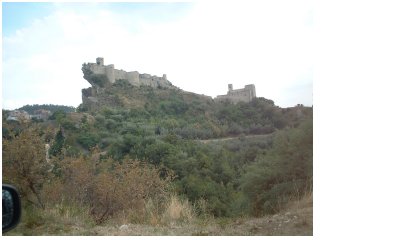
Roccascalegna - photos by Marion Porreca and Dan Aspromonte September 2006
[4] Roccolano - an inhabitant of Roccascalegna.
[5] Catanzaro - A town in Southern Italy; it is capital of the Province of the same name, Catanzaro, and it is also the capital of the Region of Calabria. Catanzaro is the seat of the Episcopal See of Calabria that was founded in 1121. The town became important thanks to its trade in olive oil, silk and velvet. Its castle was built by Robert Guiscard (c. 1015-1085) the most remarkable of the Norman adventurers who conquered southern Italy; he was essentially the hero and founder of the Norman kingdom of Italy. The castle has been modernized, and so has the cathedral. The provincial museum contains antiquities and especially coins from the ancient cities of Magna Graecia, and a few pictures.
Nowadays the city's economy is based on agriculture and allied commercial activities, as well as on a high proportion of employment in the public sector, related to municipal administration. The industrial sector is of scant importance, with only a few small factories making building materials, food, chemicals and engaged in wood processing. There is a fair amount of seaside tourism in Catanzaro Marina, but the traditional crafts of silk and velvet making have almost died out.[6] “iter” – iter, itineris (Latin) journey, way, march, route, road, passage, course
[7] Fara San Martino, near the Verde River in the province of Chieti, is located on the eastern side of the Maiella Mountains at an elevation of 1400 feet, at the mouth of one of the biggest and most beautiful valleys in the Maiella, the Valle di Santo Spirito. Because of its location, this town of 1,700 inhabitants is known as the gateway to the Maiella.
There were prehistoric settlements at Fara San Martino, as evidenced by the discovery at Grotta Porca Arcangeli (one of many caves in the area) of artefacts from the Bronze Age. The documented history of the town begins in the medieval era, in the year 829 A.D., with a record of the first Benedictine monastery in Abruzzo, San Martino in Valle, located on the outskirts of the town. The monastery was destroyed by a landslide in 1846, and all that remains visible today is part of the campanile or bell-tower.
The traditional economy of the town was based on flour-milling and on sheep-farming, which included the production and weaving of wool. Today the woollen industry is gone, but the flour mills survived and today have become a pasta-making industry - the Delverde and De Cecco pasta companies are located here.
The original historic centre of the town, a medieval nucleus known as Terra Vecchia, is easily recognized: it is at the highest point in the town and was surrounded by a wall and defensive watchtowers, traces of which still remain. A 17th century gate to Terra Vecchia, the Porta del Sole, can still be found in Fara San Martino's main square, the Piazza del Municipio. Within the Terra Vecchia section of the town are narrow winding streets and tiny squares lined with buildings, which display ancient stone-work facades, doorways, arches and balconies. Much of the town was rebuilt after the heavy bombardment of 1943.
The Gorges at Fara S. Martino The Ravine at Fara S. Martino [8] The Greens – (I Verdi) Italian branch of the worldwide political party that aims to preserve the basis of life on earth and the environment by protecting it from modern destructive trends due to industrialisation.
[9] on the top of the hill called Montepidocchio, one of the best places of Pre-roman/Roman settlements. The main relevance of this place is the position: in fact, from there it is possible to control the road network of the area and also the "Tratturo", the ancient tracks used for moving flocks. The importance of this site is also demonstrated by the remains: much pottery and in particular, impasto and black glaze pottery associated in a stratigraphical context.
[10] Montenero – or Montenerodomo – This ancient centre lies on a high rock overlooking the Adriatic to the East and the Majella to the west, and was the home of the philosopher Benedetto Croce's ancestors. Inhabited since prehistory, it was later an Italic centre of the Frentani with the name of Juvanum, and in Roman times a municipium. In the Middle Ages it was under the Caldoras, and finally the d'Aquinos. World War Two seriously damaged the centre, and was responsible for the destruction of the ancient Croce palace. There are still the remains of Megalithic walls around the settlement and the Roman remains at Juvanum “belong” to Montenerodomo. The Monastery of Santa Maria di Palazzo was built using a great number of Roman stones.
[11] Civitaluparella – lies on the high hilly slopes of a rocky spur on the southern slopes of Mount Lupari, to the left of the River Sangro, between the Corvina and Lagariello valleys. Archaeological finds show that there was a centre here dating from the 6th Century BC. Civitaluparella is mentioned in official documents of the 12th Century. In the 15th Century, the strategic position of the ancient fortifications led to its choice as a secure refuge for Antonio Caldora during his unfortunate conflict with Ferdinand of Aragon. The remains of the castle are still there.
[12] Cyclopean – relating to a Cyclops, a monstrous one-eyed giant; indicating huge size.
[13] Altino – Situated in the Aventino valley, 12 km from Lanciano, on a mountain crest to the left of the Sangro and right of the Aventino River, Altino rises along a small stream, the Rio Secco, which flows into the Adriatic a few miles away. Altino is set on a hill, which dominates the wide valley spreading right down to the Adriatic and there is a magnificent view from this small town. The fertile territory is well supplied by natural waters, is covered with vineyards and olive trees, and in the plain there is copious production of fruit. Nearby, in a place called Brecciole, there is a spring with sulphurous waters, which the people say has healing powers.
This ancient medieval borough was mentioned in Acts of the 12th century, and was under a number of different feudal lords, such as the de Anichino, Diego de Moccicao, Alvaro de Grado, Giovanni Vincenzo Crispano, the Tovo, Furia and Paolucci families. In 1861 and 1862 was repeatedly attacked by brigands, and many families moved to Casoli and Chieti.
[14] Quintals – 1 quintal = 100 Kg
|
Translation courtesy of Dr. Marion Apley Porreca
|
